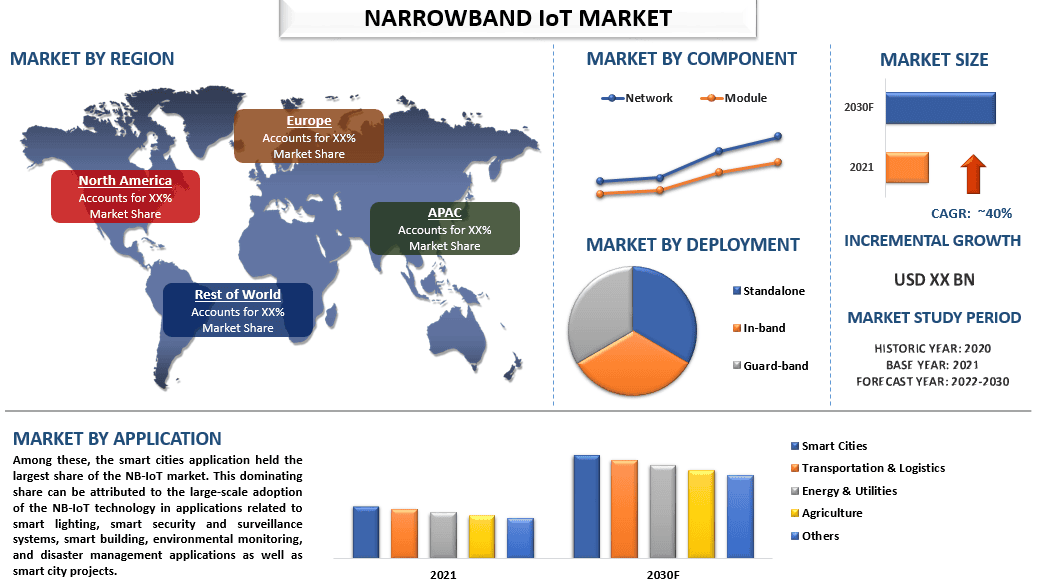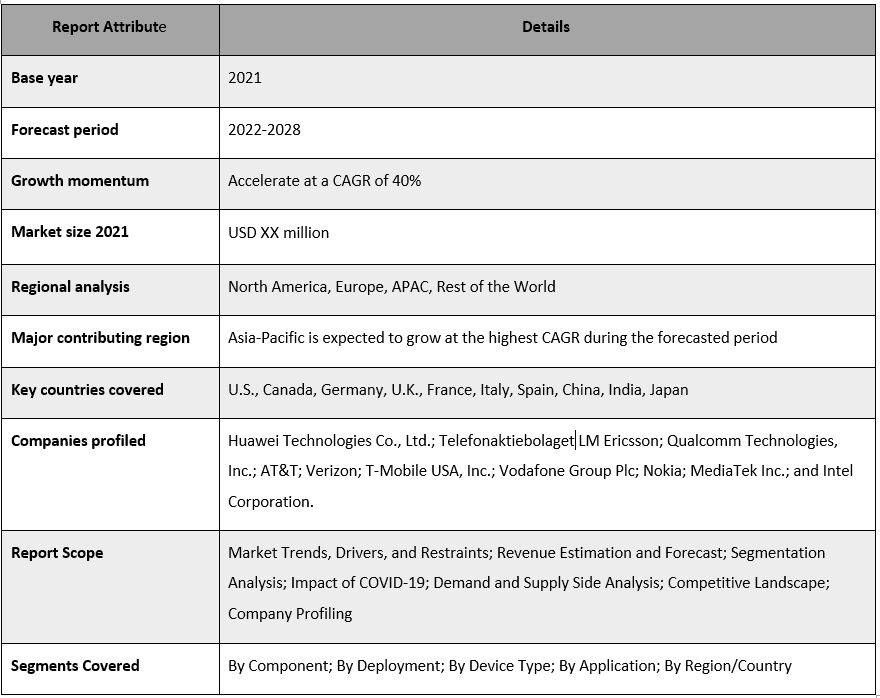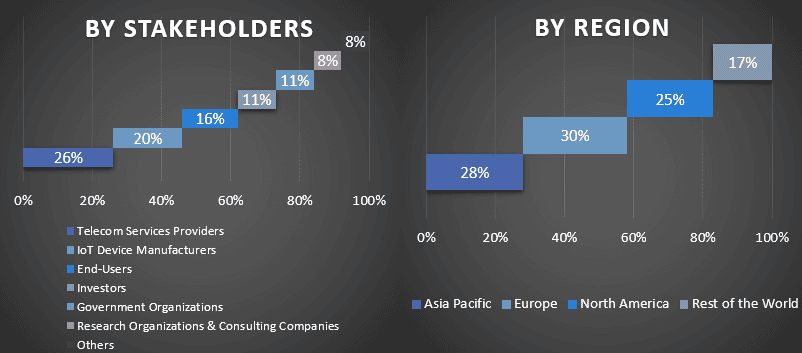- Inicio
- Acerca de nosotros
- Industria
- Servicios
- Leyendo
- Contáctenos
Mercado de Internet de las Cosas de Banda Estrecha (NB-IoT): Análisis Actual y Pronóstico (2022-2030)
Énfasis en Componente (Red y Módulo); Despliegue (Independiente, En Banda y Banda de Protección); Tipo de Dispositivo (Wearables, Rastreadores, Medidores Inteligentes, Iluminación Inteligente, Alarmas y Detectores, y Otros); Aplicación (Ciudades Inteligentes, Transporte y Logística, Energía y Servicios Públicos, Agricultura y Otros); y Región/País

Se espera que el mercado de NB-IoT crezca a un ritmo constante de alrededor del 40% durante el período de pronóstico (2022-2030) debido a la creciente adopción de IoT y dispositivos conectados, así como a la IA, ML y el análisis de big data en aplicaciones industriales y comerciales.NB-IoT es una tecnología de red de área amplia de baja potencia (LPWAN) diseñada para dispositivos IoT. Funciona en redes celulares 4G existentes, utilizando una banda estrecha de radiofrecuencia para transmitir pequeñas cantidades de datos a largas distancias. NB-IoT está diseñado para admitir una gran cantidad de dispositivos IoT de bajo ancho de banda que requieren transmisiones de datos poco frecuentes y tienen bajos requisitos de energía. Esto lo hace ideal para aplicaciones como medición inteligente, monitoreo ambiental y rastreo de activos. Además, el número cada vez mayor de dispositivos IoT a nivel mundial es uno de los factores más destacados que impulsan el crecimiento del mercado.Por ejemplo, según Ericsson, el número de dispositivos conectados por tecnologías Massive-IoT creció fuertemente en 2021 y alcanzó casi 500 millones a fines de 2022.
Algunos de los principales actores que operan en el mercado incluyen Huawei Technologies Co., Ltd.; Telefonaktiebolaget LM Ericsson; Qualcomm Technologies, Inc.; AT&T; Verizon; T‑Mobile USA, Inc.; Vodafone Group Plc; Nokia; MediaTek Inc.; e Intel Corporation. Varios M&A junto con asociaciones han sido emprendidas por estos actores para facilitar a los clientes productos/tecnologías innovadores y de alta tecnología.
Información Presentada en el Informe
“Entre los componentes, el segmento de red mantuvo una cuota dominante del mercado en 2021”
Según el componente, el mercado se divide en red y módulo. El segmento de red mantuvo una cuota dominante del mercado en 2021 debido a la alta adopción de redes NB-IoT debido a su rentabilidad, menores costos de implementación y menores costos operativos. Ofrecen mejor cobertura y un alcance más largo que las redes celulares tradicionales y están diseñadas para operar en entornos desafiantes donde otras tecnologías inalámbricas pueden no ser prácticas.
“Entre el despliegue, el segmento de banda de protección mantuvo la cuota significativa del mercado en 2021”
Sobre la base del despliegue, el mercado se clasifica en independiente, en banda y banda de protección. Entre estos, la banda de protección atendió una parte significativa del mercado en 2021 y se espera que crezca a una robusta CAGR durante el período de pronóstico. Uno de los factores más importantes que impulsan la expansión de este mercado es la capacidad de utilizar la infraestructura celular que ya está en su lugar, como antenas y módulos de Radio Frecuencia (RF), sin tener que incurrir en costos adicionales por espectro.
“América del Norte dominó el mercado de NB-IoT en 2021”
América del Norte dominó el mercado global de NB-IoT en 2021. Varios fabricantes de dispositivos y proveedores de servicios de red prominentes en América del Norte se concentran en la prueba y comercialización de soluciones de aplicaciones para consumidores e industriales. Qualcomm Inc., AT&T, Cellco Partnership (Verizon Wireless), T-Mobile US, Inc., Intel Corporation y Verizon Wireless son algunos de estos operadores de red y fabricantes de dispositivos.El mercado regional de América del Norte también está siendo impulsado por otros factores importantes, como el aumento de los ingresos disponibles, una población creciente de personas expertas en tecnología y la adopción continua de nuevas tecnologías para fines personales y comerciales.
Cobertura del Informe del Mercado de NB-IoT

Razones para comprar este informe:
- El estudio incluye dimensionamiento del mercado y análisis de pronóstico validados por expertos clave de la industria autenticados.
- El informe presenta una revisión rápida del rendimiento general de la industria de un vistazo.
- El informe cubre un análisis en profundidad de los pares prominentes de la industria con un enfoque principal en las finanzas comerciales clave, las carteras de productos, las estrategias de expansión y los desarrollos recientes.
- Examen detallado de los impulsores, restricciones, tendencias clave y oportunidades que prevalecen en la industria.
- El estudio cubre ampliamente el mercado en diferentes segmentos.
- Análisis en profundidad a nivel regional de la industria.
Opciones de Personalización:
El mercado global de NB-IoT puede personalizarse aún más según el requisito o cualquier otro segmento del mercado. Además de esto, UMI entiende que puede tener sus propias necesidades comerciales, por lo tanto, no dude en conectarse con nosotros para obtener un informe que se adapte completamente a sus requisitos.
Tabla de contenido
Metodología de Investigación para el Análisis del Mercado de Internet de las Cosas de Banda Estrecha (NB-IoT) (2022-2030)
Analizar el mercado histórico, estimar el mercado actual y pronosticar el mercado futuro del mercado global de NB-IoT fueron los tres pasos principales realizados para crear y analizar la adopción de NB-IoT en las principales regiones a nivel mundial. Se realizó una exhaustiva investigación secundaria para recopilar los números históricos del mercado y estimar el tamaño actual del mercado. En segundo lugar, para validar estos conocimientos, se tuvieron en cuenta numerosos hallazgos y suposiciones. Además, también se realizaron entrevistas primarias exhaustivas, con expertos de la industria en toda la cadena de valor del mercado global de NB-IoT. Después de la suposición y validación de los números del mercado a través de entrevistas primarias, empleamos un enfoque de arriba hacia abajo/abajo hacia arriba para pronosticar el tamaño completo del mercado. Posteriormente, se adoptaron métodos de desglose del mercado y triangulación de datos para estimar y analizar el tamaño del mercado de los segmentos y subsegmentos de la industria a la que pertenece. La metodología detallada se explica a continuación:
Análisis del Tamaño Histórico del Mercado
Paso 1: Estudio en Profundidad de Fuentes Secundarias:
Se realizó un estudio secundario detallado para obtener el tamaño histórico del mercado del mercado de NB-IoT a través de fuentes internas de la empresa, tales comoinformes anuales y estados financieros, presentaciones de rendimiento, comunicados de prensa, etc.,y fuentes externas, incluyendorevistas, noticias y artículos, publicaciones gubernamentales, publicaciones de la competencia, informes sectoriales, base de datos de terceros y otras publicaciones creíbles.
Paso 2: Segmentación del Mercado:
Después de obtener el tamaño histórico del mercado del mercado de NB-IoT, realizamos un análisis secundario detallado para recopilar información histórica del mercado y la participación de los diferentes segmentos y subsegmentos para las principales regiones. Los principales segmentos se incluyen en el informe como componente, despliegue, tipo de dispositivo y aplicación. Además, se realizaron análisis a nivel de país para evaluar la adopción general de los modelos de prueba en esa región.
Paso 3: Análisis de Factores:
Después de adquirir el tamaño histórico del mercado de diferentes segmentos y subsegmentos, realizamos un detalladoanálisis de factorespara estimar el tamaño actual del mercado del mercado de NB-IoT. Además, realizamos un análisis de factores utilizando variables dependientes e independientes, como el componente, el despliegue, el tipo de dispositivo y la aplicación del mercado de NB-IoT. Se realizó un análisis exhaustivo de los escenarios de la oferta y la demanda, considerando las principales asociaciones, fusiones y adquisiciones, expansión comercial y lanzamientos de productos en el sector del mercado de NB-IoT en todo el mundo.
Estimación y Pronóstico del Tamaño Actual del Mercado
Dimensionamiento Actual del Mercado:Basándonos en los conocimientos prácticos de los 3 pasos anteriores, llegamos al tamaño actual del mercado, los actores clave en el mercado global de NB-IoT y las cuotas de mercado de los segmentos. Todas las divisiones de cuotas porcentuales requeridas y los desgloses del mercado se determinaron utilizando el enfoque secundario antes mencionado y se verificaron a través de entrevistas primarias.
Estimación y Pronóstico:Para la estimación y el pronóstico del mercado, se asignaron ponderaciones a diferentes factores, incluidos los impulsores y las tendencias, las restricciones y las oportunidades disponibles para las partes interesadas. Después de analizar estos factores, se aplicaron técnicas de pronóstico relevantes, es decir, el enfoque de arriba hacia abajo/abajo hacia arriba, para llegar al pronóstico del mercado para 2030 para diferentes segmentos y subsegmentos en los principales mercados a nivel mundial. La metodología de investigación adoptada para estimar el tamaño del mercado abarca:
- Tamaño del mercado de la industria, en términos de ingresos (USD) y la tasa de adopción del mercado NB-IoT en los principales mercados a nivel nacional
- Todas las cuotas porcentuales, divisiones y desgloses de los segmentos y subsegmentos del mercado
- Actores clave en el mercado global de NB-IoT en términos de productos ofrecidos. Además, las estrategias de crecimiento adoptadas por estos actores para competir en el mercado de rápido crecimiento
Validación del tamaño y la cuota de mercado
Investigación primaria:Se realizaron entrevistas en profundidad con los Líderes de Opinión Clave (KOL) que incluyeron Ejecutivos de Alto Nivel (CXO/VP, Jefe de Ventas, Jefe de Marketing, Jefe Operacional, Jefe Regional, Jefe de País, etc.) en las principales regiones. Los hallazgos de la investigación primaria se resumieron y se realizó un análisis estadístico para demostrar la hipótesis planteada. Los aportes de la investigación primaria se consolidaron con los hallazgos secundarios, convirtiendo así la información en información procesable.
División de los participantes primarios en diferentes regiones

Ingeniería de mercado
Se empleó la técnica de triangulación de datos para completar la estimación general del mercado y llegar a números estadísticos precisos para cada segmento y subsegmento del mercado global de NB-IoT. los datos se dividieron en varios segmentos y subsegmentos después de estudiar varios parámetros y tendencias en las áreas del componente, la implementación, el tipo de dispositivo y la aplicación en el mercado global de NB-IoT.
El objetivo principal del estudio del mercado global de NB-IoT
Las tendencias actuales y futuras del mercado global de NB-IoT se identificaron en el estudio. Los inversores pueden obtener información estratégica para basar su discreción para inversiones en el análisis cualitativo y cuantitativo realizado en el estudio. Las tendencias actuales y futuras del mercado determinaron el atractivo general del mercado a nivel regional, proporcionando una plataforma para que el participante industrial explote el mercado sin explotar para beneficiarse de la ventaja del primero en actuar. Otros objetivos cuantitativos de los estudios incluyen:
- Analizar el tamaño actual y previsto del mercado de NB-IoT en términos de valor (USD). Además, analizar el tamaño actual y previsto del mercado de diferentes segmentos y subsegmentos
- Los segmentos en el estudio incluyen las áreas del componente, la implementación, el tipo de dispositivo y la aplicación
- Definición y análisis del marco regulatorio para la industria NB-IoT
- Analizar la cadena de valor involucrada con la presencia de varios intermediarios, junto con el análisis de los comportamientos de los clientes y competidores de la industria
- Analizar el tamaño actual y previsto del mercado de NB-IoT para la región principal
- Los principales países de las regiones estudiadas en el informe incluyen Asia Pacífico, Europa, América del Norte y el resto del mundo
- Perfiles de empresas del mercado de NB-IoT y las estrategias de crecimiento adoptadas por los actores del mercado para sostenerse en el mercado de rápido crecimiento
- Análisis a nivel regional en profundidad de la industria
Relacionados Informes
Los clientes que compraron este artículo también compraron










